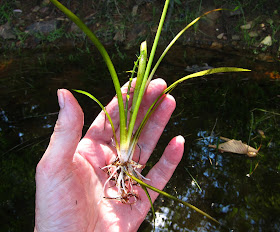Boy, is my face red! And not just because I was under the midday sun for hours today, on one of the hottest days of the year. No, my face is red from embarrassment, having leaped to the conclusion that the arrowhead plant I found yesterday was the very rare Slender Arrowhead ( Sagittaria teres). I do believe I was wrong about that.
Looking again at the specimen I brought home, I noticed a long thin leaf that was flattened at the top. Uh oh, I thought, this looks like it could be the far more common Grass-leaved Arrowhead (S. graminea) after all.
So I returned to where I was paddling yesterday, a backwater just above the Feeder Dam at South Glens Falls, and there I found a couple of other arrowhead plants with similar long thin leaves that were flattened at the top.
All of the other arrowheads surrounding these plants exhibited the more broadly flattened leaves that are typical of Grass-leaved Arrowhead.
I dug around in the mud and extracted the basal rosette of one of the plants I was sure was Grass-leaved Arrowhead. It looked exactly like the rosette of the plant I had found yesterday. ( I see a single stalk of Golden Pert has sprouted among those leaves, as well.)
I broke a leaf in two and noted that the cross-section of the leaf was not completely round, but only half-round. When I returned home, I checked the leaves of my specimen, and discovered that they were half-round as well.
When I checked my Newcomb's Wildflower Guide again, it seems obvious how I was misled. Newcomb's does not illustrate the basal leaves of the Grass-leaved Arrowhead, which are usually submerged. His drawing shows only the bladed leaves, which protrude above the water. Just at a glance, the plant I found yesterday certainly more closely resembled Newcomb's illustration of the Slender Arrowhead. But it probably isn't. Oh well. I did have a moment's excitement.
I certainly wasn't going to let my embarrassment prevent my from enjoying the rest of the afternoon on the river, although the brisk wind that started to blow convinced me to move to a more sheltered area.
So I drove upstream to an area above the Sherman Island Dam where I almost always find peaceful waters. My personal name for this place is Shelter Cove.
The Cardinal Flowers are coming into their glory now, the ravishing red of this cluster set off so beautifully by a large clump of Royal Fern. I see some pretty blue dots of Monkey Flower as well.
Purple Loosestrife is also coming into its glory, and oh, how I wish I could leave these plants where I find them, adding so much beauty to the riverbanks. Maybe someday they will reach an equilibrium where they don't aggressively drive out our native flowers. As yet, however, I pull them out wherever I find them. But first I took their photo. So lovely!
I stopped off on the island where a healthy group of Great St. Johnsworts have found a happy home. Even though their flowers have dropped all their bright-yellow petals, it's easy to locate them by their big fat achenes, topped by the five-parted stigmas that are typical of this plant.
And oh, it was my lucky day, indeed! The exquisite Marsh St. Johnswort had opened its pretty pink petals at last! I was afraid to turn around, lest they close them up again, having reached their daily allotment of blooming time. It really is a stroke of luck to find these in bloom. Such nice compensation for my other disappointment.
I was also cheered by the presence of this pretty little Green Frog. Then, while leaning in close to admire the frog, I noticed the arcing green threadlike stems of Creeping Spearwort making their way across the rock. With water levels in the Hudson so low this month, this plant, which has bided its time underwater for years, seems to be burgeoning everywhere, taking advantage of sunlight and air to bloom at last.













Of course I'm charmed by the plants and flowers (and you certainly need not be embarrassed on my account!) but those boulders in your Shelter Cove! They look about the same, I guess, as they did when the glacier dropped 'em there.
ReplyDeleteWe've had some great success with the beetle that is released to munch on the purple loosestrife. Maybe you should seek out a supply and start turning 'em loose where you find this plant!
ReplyDeletewell don't fret, I came home after that day on the river, and looked at the drawings for slender arrowhead on the usda site, the plant seemed to match those, too ... right down to the quillwort-like lines on the whiter part of the leaves. Oh well.
ReplyDeleteThat marsh st. j. looks like the prettiest gift-wrap ribbon !